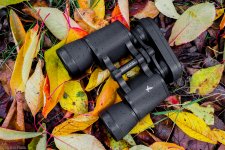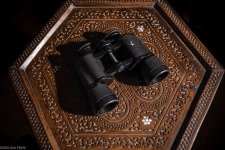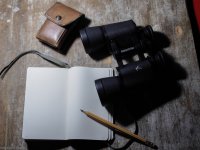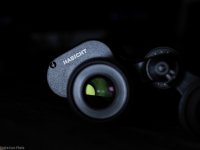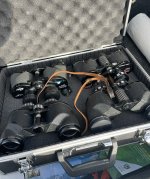dorubird
The unskilled mechanic blames his tools!

History
Those interested in optics know that the first Swarovski binoculars appeared in 1935, in 6x30 format. Then the optical department of the Swarovski company (Swarovski Optik KG) was established in 1949. This series of Habicht binoculars has been manufactured since 1949. The mechanics and optical formula are practically the same and with the same specifications. However, with the passage of time, the glass, the coating and the materials were improved and refined. There are many versions of Habicht 7x42 that have improved over the years until today. If the models from 1949 had about 50% light transmission, the versions from the last few years have the coating and glass taken to the heights of mastery, letting 96% of the light to pass through. Even at the extreme ends of the visual spectrum, more than 90%-95% of the light passes through.
Here we can find interesting binoculars test and compare, where we can find valuable information related to the light transmission of many binoculars:
 www.houseofoutdoor.com
www.houseofoutdoor.com

Mechanics, finishes, design
The binoculars weigh 640g without accessories, and feel very dense in the hands, announcing a very robust and resistant mechanism. It has an aluminum/magnesium alloy structure. It is filled with inert gas, being resistant to immersion in water up to 4m. The design is classic, keeping exactly the lines of the Habicht series since its beginnings, being covered with a beautiful black leather. The only negative finishes exception is the inscriptions on the prism covers, which on the new versions are painted instead of engraved! But the mechanics and construction have been preserved from the times when things were manufactured to last as long as possible, for generations. PERFECT

Ergonomics. It has a bit bony architecture shape for me, but it feels good in the hands, creating that pleasure of holding a quality, classic and very robust instrument. It gives me the impression of a weapon mechanism! GOOD
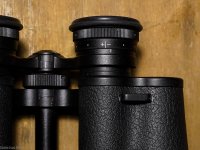
The dioptre adjustment and the interpupillary distance adjustment move firmly and precisely requiring a bit of force (useful thing to stay as they are set). PERFECT
The eye relief is very poor at only 14mm. But with the glasses, I can see at the limit the entire visual field. GOOD
Friends of mine, who don't wear glasses, have had problems with rubber cups that are too small in diameter and press on the eyeball. It also requires careful positioning of the eyepieces for a flawless image. POOR
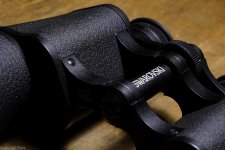
The focus also moves with difficulty, which is advantageous only for static observations of astronomy, but not exactly ideal for birding. It has a bit more than one rotation from infinity to 3.1 meter GOOD
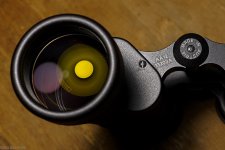
The objective has a very nice coating of olive color with a very slight purple hint. The porro prisms are golden coated!
At certain angles you get the amazing impression that the lenses do not have glass!! It is very clean inside with matte black walls without strong reflections
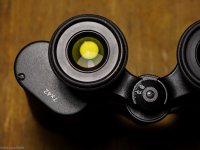
The eyepieces have the same olive color coating, being made of 3 lenses in two groups (Kellner).
These simple eyepieces are what give the spartan personality of these binoculars!
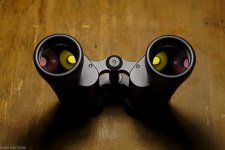
Contrast, Resolution, Brightness, Color Reproduction
The binoculars excel with a very high contrast (the highest I've encountered in binoculars). It has even higher contrast than the Nikon E2, which is already a binocular with a very high contrast. PERFECT
The resolution is also fantastic, surpassing many 8x binoculars. The resolution extends to about 90% of the FOV, the stars being point-shaped and extremely sparkling! PERFECT
The light transmission is immense...96%. The simple optics made up of porro prisms and only 5 lenses (a group of two lenses at the objective and three lenses in two groups at the eyepiece) also contribute to this amazing transmission. Of course, glass and the "alien" Swarovski coating are added to these. It is a binocular with dusk and night applications. It is very useful in astronomy, especially when observing nebulae spread over very large surfaces, which require large exit pupils and binoculars with the highest possible transmission. PERFECT
The color rendering is impeccable. Practically any binoculars compared to it will have a slight tint of color!!! The transmission graph is maintained above 90% on all wavelengths. PERFECT
All these four optical qualities give the image a clarity with an amazing sparkle of details.
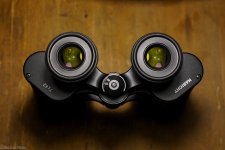
Chromatic aberrations are very well managed, appearing very discreetly only on the edges. GOOD
The geometric distortion is very small only on the edges. GOOD
It has a fairly good resistance to light during the day. But at night, in certain situations, when the pupil of the eye dilates, the presence of strong light sources near the FOV (lantern, moon, etc.) can cause a reflection on the edge of the FOV. GOOD
The field of view is not great: only 6.5 degrees resulting in an AFOV of 46 degrees. This is the great optical sacrifice! But I will learn, in time, not to annoy me that anymore! POOR
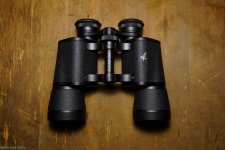
Conclusions
Basically, when the old format, with its exemplary and robust mechanics, meets top modern optics, new Habicht is born!
Habicht 7x42 is a benchmark of binoculars when it comes to contrast, brightness and color reproduction. And the resolution is the best on 7x class tested by me.
It is not a binocular for beginners, because it has a very strong personality. It reminds me of orthoscopic astronomical eyepieces! It is a curiosity of optics and mechanics! You might hate him at the first meeting! Personally, I really like this Habicht because it is a spartan binocular due to its extremely simple optical construction and by sacrificing the visual field, but precisely these sacrifices achieves this unique unreal mixture of contrast/brightness/resolution.
Those interested in optics know that the first Swarovski binoculars appeared in 1935, in 6x30 format. Then the optical department of the Swarovski company (Swarovski Optik KG) was established in 1949. This series of Habicht binoculars has been manufactured since 1949. The mechanics and optical formula are practically the same and with the same specifications. However, with the passage of time, the glass, the coating and the materials were improved and refined. There are many versions of Habicht 7x42 that have improved over the years until today. If the models from 1949 had about 50% light transmission, the versions from the last few years have the coating and glass taken to the heights of mastery, letting 96% of the light to pass through. Even at the extreme ends of the visual spectrum, more than 90%-95% of the light passes through.
Here we can find interesting binoculars test and compare, where we can find valuable information related to the light transmission of many binoculars:
Verrekijker testen | House Of Outdoor & Optics
Hier vindt u allerlei testen van verrekijkers en telescopen van Dr. G. van Ginkel. Dit kan nuttig zijn bij de aanschaf keuze van uw verrekijker of telescoop.

Mechanics, finishes, design
The binoculars weigh 640g without accessories, and feel very dense in the hands, announcing a very robust and resistant mechanism. It has an aluminum/magnesium alloy structure. It is filled with inert gas, being resistant to immersion in water up to 4m. The design is classic, keeping exactly the lines of the Habicht series since its beginnings, being covered with a beautiful black leather. The only negative finishes exception is the inscriptions on the prism covers, which on the new versions are painted instead of engraved! But the mechanics and construction have been preserved from the times when things were manufactured to last as long as possible, for generations. PERFECT

Ergonomics. It has a bit bony architecture shape for me, but it feels good in the hands, creating that pleasure of holding a quality, classic and very robust instrument. It gives me the impression of a weapon mechanism! GOOD

The dioptre adjustment and the interpupillary distance adjustment move firmly and precisely requiring a bit of force (useful thing to stay as they are set). PERFECT
The eye relief is very poor at only 14mm. But with the glasses, I can see at the limit the entire visual field. GOOD
Friends of mine, who don't wear glasses, have had problems with rubber cups that are too small in diameter and press on the eyeball. It also requires careful positioning of the eyepieces for a flawless image. POOR

The focus also moves with difficulty, which is advantageous only for static observations of astronomy, but not exactly ideal for birding. It has a bit more than one rotation from infinity to 3.1 meter GOOD

The objective has a very nice coating of olive color with a very slight purple hint. The porro prisms are golden coated!
At certain angles you get the amazing impression that the lenses do not have glass!! It is very clean inside with matte black walls without strong reflections

The eyepieces have the same olive color coating, being made of 3 lenses in two groups (Kellner).
These simple eyepieces are what give the spartan personality of these binoculars!

Contrast, Resolution, Brightness, Color Reproduction
The binoculars excel with a very high contrast (the highest I've encountered in binoculars). It has even higher contrast than the Nikon E2, which is already a binocular with a very high contrast. PERFECT
The resolution is also fantastic, surpassing many 8x binoculars. The resolution extends to about 90% of the FOV, the stars being point-shaped and extremely sparkling! PERFECT
The light transmission is immense...96%. The simple optics made up of porro prisms and only 5 lenses (a group of two lenses at the objective and three lenses in two groups at the eyepiece) also contribute to this amazing transmission. Of course, glass and the "alien" Swarovski coating are added to these. It is a binocular with dusk and night applications. It is very useful in astronomy, especially when observing nebulae spread over very large surfaces, which require large exit pupils and binoculars with the highest possible transmission. PERFECT
The color rendering is impeccable. Practically any binoculars compared to it will have a slight tint of color!!! The transmission graph is maintained above 90% on all wavelengths. PERFECT
All these four optical qualities give the image a clarity with an amazing sparkle of details.

Chromatic aberrations are very well managed, appearing very discreetly only on the edges. GOOD
The geometric distortion is very small only on the edges. GOOD
It has a fairly good resistance to light during the day. But at night, in certain situations, when the pupil of the eye dilates, the presence of strong light sources near the FOV (lantern, moon, etc.) can cause a reflection on the edge of the FOV. GOOD
The field of view is not great: only 6.5 degrees resulting in an AFOV of 46 degrees. This is the great optical sacrifice! But I will learn, in time, not to annoy me that anymore! POOR

Conclusions
Basically, when the old format, with its exemplary and robust mechanics, meets top modern optics, new Habicht is born!
Habicht 7x42 is a benchmark of binoculars when it comes to contrast, brightness and color reproduction. And the resolution is the best on 7x class tested by me.
It is not a binocular for beginners, because it has a very strong personality. It reminds me of orthoscopic astronomical eyepieces! It is a curiosity of optics and mechanics! You might hate him at the first meeting! Personally, I really like this Habicht because it is a spartan binocular due to its extremely simple optical construction and by sacrificing the visual field, but precisely these sacrifices achieves this unique unreal mixture of contrast/brightness/resolution.







